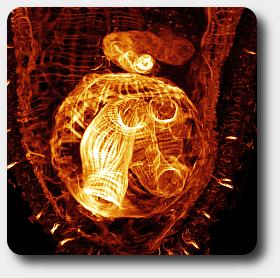Well for children anyway:
"The less a child sleeps, the more likely he or she is to become overweight, according to researchers from Université Laval's Faculty of Medicine in an article published in the latest edition of the International Journal of Obesity. The risk of becoming overweight is 3.5 times higher in children who get less sleep than in those who sleep a lot, according to researchers Jean-Philippe Chaput, Marc Brunet, and Angelo Tremblay." [VIA]
There seems to be a direct causal link between short periods of sleep and reduced levels of leptin and higher levels of ghrelin. This seems to cause increased appetite and thus BMI so this association between a lack of sleep and obesity is probably true for everyone.
I suspect a major cause of sleep deprivation in children and adults is excessive television watching and also sadly computer use.
References:
Chaput JP, Brunet M, Tremblay A.Int J Obes (Lond). 2006 Mar 14; [Epub ahead of print]
Relationship between short sleeping hours and childhood overweight/obesity:
results from the 'Quebec en Forme' Project. [LINK]
Taheri S, Lin L, Austin D, Young T, Mignot E.
PLoS Med. 2004 Dec;1(3):e62. Epub 2004 Dec 7.
Short sleep duration is associated with reduced leptin, elevated ghrelin, and
increased body mass index. [LINK - full text]
Wednesday, March 29, 2006
Friday, March 24, 2006
Glaciers in retreat
Three Papers in the current issue of Science show the rapid changes that are occurring in world's glaciers.
Paleoclimatic Evidence for Future Ice-Sheet Instability and Rapid Sea-Level Rise
Jonathan T. Overpeck, Bette L. Otto-Bliesner, Gifford H. Miller, Daniel R. Muhs, Richard B. Alley, and Jeffrey T. Kiehl
Science 24 March 2006: 1747-1750.
Simulating Arctic Climate Warmth and Icefield Retreat in the Last Interglaciation
Bette L. Otto-Bliesner, Shawn J. Marshall, Jonathan T. Overpeck, Gifford H. Miller, Aixue Hu, and CAPE Last Interglacial Project members
Science 24 March 2006: 1751-1753.
Measurements of Time-Variable Gravity Show Mass Loss in Antarctica
Isabella Velicogna and John Wahr
Science 24 March 2006: 1754-1756.
Published online 2 March 2006 [DOI: 10.1126/science.1123785] (in Science Express Reports)
Press for these papers:
Sea rise could be 'catastrophic' (BBC)
Polar Meltdown Near: Seas Could Rise 3 Feet Per Century (Livescience)
Thursday, March 23, 2006
Ediacaran website
While browsing the internet for information on those strange ediacaran creatures I stumbled upon this russian website: http://vend.paleo.ru/ If you are interested in these mysterious creatures it's worth a look.
Although it is all in russian Babelfish does a fairly decent translation, here is their description of the site:
"Our laboratory is occupied by the complex of the early stages of the evolution of biosphere, which preceded the phanerozoic jump of bioraznoobraziya. Special attention in this case is paid to the vendskomu period as to the period, which completes the Proterozoic stage of the evolution of biosphere. For a long time considered as the almost silent, this section of geological chronicle is at the present time remarkable with this number of surprising findings of the remainders of undoubtedly organic nature, that it is possible to indicate that we already see the letters, which wrote the history of the evolution of the biosphere of that time, but yet we cannot understand entire text, which is collected by these letters. On this site are assembled the meaningful results of the work of our laboratory, materials about the directions of research activity, most significant publications, debatable materials."
Being russian they call this period (from the gaskiers glaciation to the cambrian, 632-542 MYA) the vendian even though the internationally accepted name is now the ediacaran.
There is lots of interesting stuff there, the best stuff is probably a nice selection of papers in english and russian that can be downloaded: http://vend.paleo.ru/pub_ru.php & http://vend.paleo.ru/pub_eng.php. Particularly good is 'Ivantsov Malakhovskaya 2003' which is in russian and has some amazing images of ediacaran fossils.
Their research is mainly conducted on the remarkable fossils found in cliffs by the white sea in russia. Other ediacaran localities are the Ediacra hills Australia, Mistaken point Canada, Charnwood in England and Namibia.
Their research is mainly conducted on the remarkable fossils found in cliffs by the white sea in russia. Other ediacaran localities are the Ediacra hills Australia, Mistaken point Canada, Charnwood in England and Namibia.
Tuesday, March 21, 2006
sharovipteryx

The only fossil specimen of Sharovipteryx mirabilis
Sharovipteryx mirabilis is one of the odder creatures to be found in the fossil record notable because it seems to have wings on it's hind limbs which seems to be a unique adaptation.
A new paper is in press in the Journal of Evolutionary Biology that proposes a model of how this strange beast would have flown. Their reconstruction is shown below. I have no idea if this is actually what the creature would have looked like but it seems like a fairly logical interpretation of the fossil.
 Flight of Sharovipteryx mirabilis: the world’s first delta-winged
Flight of Sharovipteryx mirabilis: the world’s first delta-wingedglider. G. J. DYKE, R. L. NUDDS & J. M. V. RAYNER. Journal evolutionary biology (in press) doi:10.1111/j.1420-9101.2006.01105.x
Wednesday, March 15, 2006
Frog spawn


The common frog (Rana temporaria) mating and spawning season is in full swing in the garden pond. There is a fairly large amount of spawn this year. Although thats only half the battle, lets hope there isn't another really cold snap so it doesn't all die, and that it stays healthy so there is a nice big crop of froglets this year.
I have a lingering fondness for frogspawn after playing with it when i was young and I still remember being fascinated watching the tadpoles develop. I am sure that is one of the things that made me interested in biology and conservation.
Links:
Declining Amphibians Population Task Force (DAPTF)
herpetofauna
froglife
Monday, March 13, 2006
How to buy fish with a clear conscience
There is a nice article in todays Independent called 'How to buy fish with a clear conscience'
"For years, the unpalatable details of the industry that delivers fish to supermarket shelves have been a well-kept secret, along with the scientific data that shows that some fish are being fished to near-extinction. But not any longer.
The ranks of enlightened fish consumers grow by the day, and proof that some of the supermarkets are waking up to the issue arrived when Greenpeace scaled the Asda headquarters in Leeds in January. No sooner was a banner unfurled from the roof depicting some of the dead and mutilated by-catch, than the campaigners were ushered inside for a chat about the sustainability of the supermarket's fish-buying policies.
Asda, which was rock bottom of a Greenpeace table of supermarkets ranked on their fish-buying policies several months ago, and in the bottom half of a similar Marine Conservation Society (MCS) table published earlier this month, announced immediately that it was removing skate wings, Dover sole, ling and dogfish from its stores. Since Asda's move, Sainsbury's has announced that it will no longer sell skate and huss, both endangered, while in the US, the discount giant Wal-Mart (which owns Asda) has declared that it will buy all of its fresh fish from sustainable sources within three to five years.
.....
Not all fish are so problematic. Lemon sole, red mullet, red gurnard and most salmon are generally acceptable, while Atlantic halibut, skate, swordfish and marlin are not. If a blue certification logo (a fish and a tick) is stamped on a product, it is one of the 50 products accredited by the Marine Stewardship Council, and is sustainable."
Marine conservation is a very important area that is often ignored because of the fishing lobby. This has led to awful mismanagement of fish resources, lets hope that consumer power can change things.
Some resources:
marine conservation society report mentioned in the article: http://www.mcsuk.org/press/press_release.php?cust_id=62
fish online
greenpeace sustainable fish campaign
Marine Stewardship Council
Marine Conservation Biology Institute
save the high seas
What You Can Do to Save the Deep Sea
"For years, the unpalatable details of the industry that delivers fish to supermarket shelves have been a well-kept secret, along with the scientific data that shows that some fish are being fished to near-extinction. But not any longer.
The ranks of enlightened fish consumers grow by the day, and proof that some of the supermarkets are waking up to the issue arrived when Greenpeace scaled the Asda headquarters in Leeds in January. No sooner was a banner unfurled from the roof depicting some of the dead and mutilated by-catch, than the campaigners were ushered inside for a chat about the sustainability of the supermarket's fish-buying policies.
Asda, which was rock bottom of a Greenpeace table of supermarkets ranked on their fish-buying policies several months ago, and in the bottom half of a similar Marine Conservation Society (MCS) table published earlier this month, announced immediately that it was removing skate wings, Dover sole, ling and dogfish from its stores. Since Asda's move, Sainsbury's has announced that it will no longer sell skate and huss, both endangered, while in the US, the discount giant Wal-Mart (which owns Asda) has declared that it will buy all of its fresh fish from sustainable sources within three to five years.
.....
Not all fish are so problematic. Lemon sole, red mullet, red gurnard and most salmon are generally acceptable, while Atlantic halibut, skate, swordfish and marlin are not. If a blue certification logo (a fish and a tick) is stamped on a product, it is one of the 50 products accredited by the Marine Stewardship Council, and is sustainable."
Marine conservation is a very important area that is often ignored because of the fishing lobby. This has led to awful mismanagement of fish resources, lets hope that consumer power can change things.
Some resources:
marine conservation society report mentioned in the article: http://www.mcsuk.org/press/press_release.php?cust_id=62
fish online
greenpeace sustainable fish campaign
Marine Stewardship Council
Marine Conservation Biology Institute
save the high seas
What You Can Do to Save the Deep Sea
Monday, March 06, 2006
cool origami

There are some amazing origami design created for ther MIT origami competition (via) Two of the winners are Jason Ku and Brian Chan and several neat designs are available from their websites. The cool Katydid in the picture is by Brian Chan (link) and there are several other nice insect designs available on his website.
Friday, March 03, 2006
Awesome micrographs

Veliger larva of the gastropod, Fusitriton oregonensis by Louise Page
 Posterior of juvenile kinorhynch, Pycnophyes kielensis by Andreas Schnidt-Rhaesa
Posterior of juvenile kinorhynch, Pycnophyes kielensis by Andreas Schnidt-Rhaesa
Copulatory organs of the acoel, Haplocelis dichona by Matthew Hooge
All images & captions from here
These remarkable images are produced by Confocal Laser Scanning Microscopy and show what amazing detail modern technology can reveal.
The images were presented at a conference called 'The New Microscopy: Novel Characters and the Importance of Morphology in Phylogenetic Analysis'. Several papers from this conference are now avilable from the journal Integrative and Comparative Biology which seems to be open access. Lots of interesting stuff has appeared in that journal, the archives are well worth a browse.
Here are the relavent papers:
Subscribe to:
Comments (Atom)


